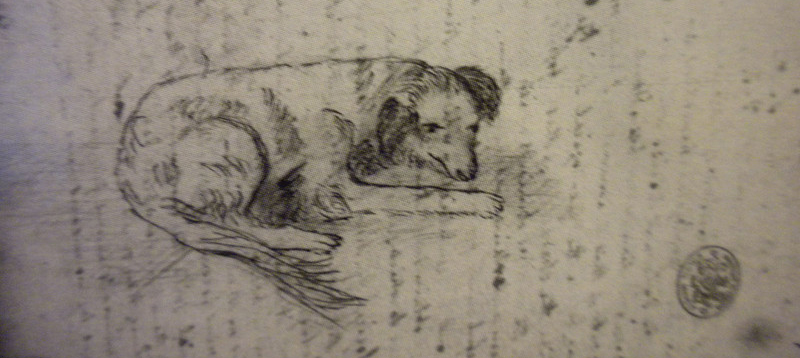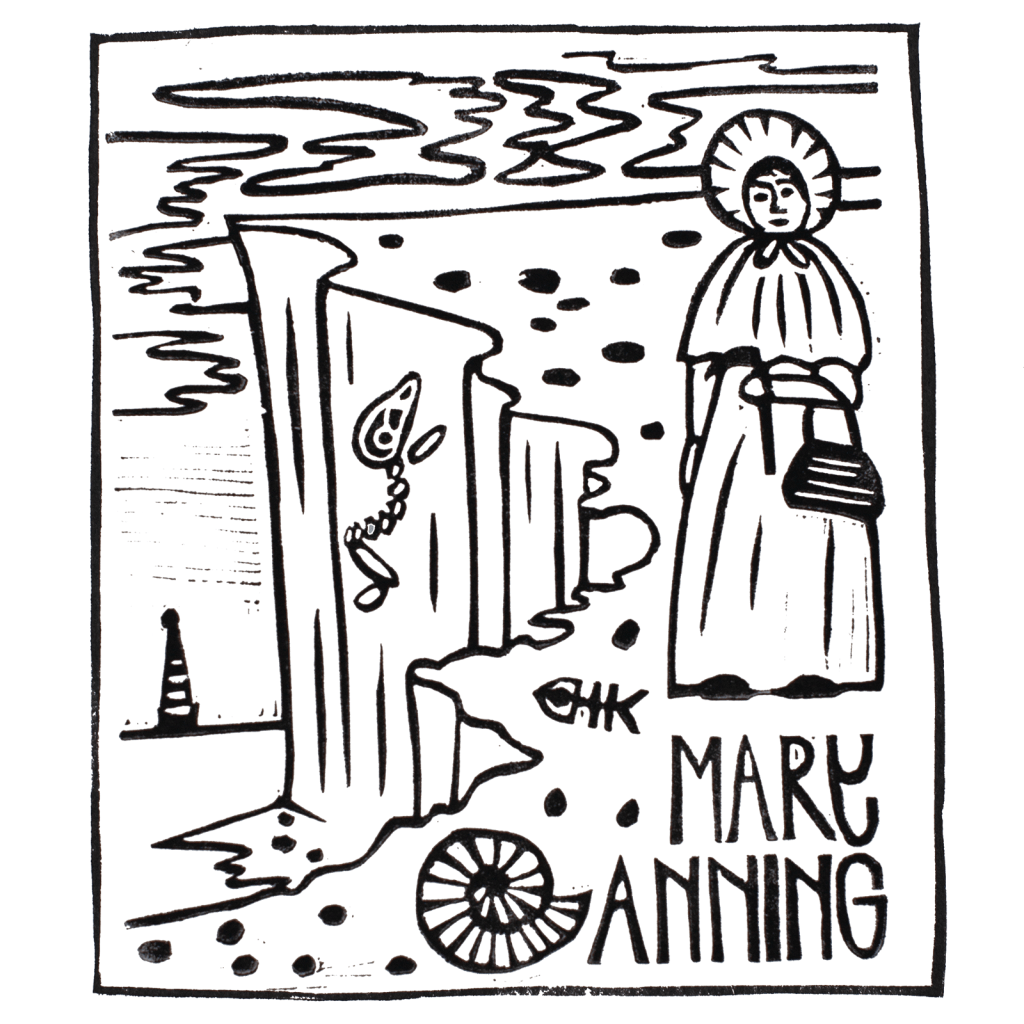Mary Anning was a 19th-century fossil hunter and self-taught palaeontologist. Her finds and knowledge furthered the field of palaeontology when it was still a new field in science. You could even say her findings changed our perception of the origins of life on earth. The following cartoon by Kate Beaton sums up the story brilliantly:

‘Mary Anning’, Kate Beaton
Mary Anning lived in the English Dorset seaside town of Lyme Regis, popular with tourists during the Napoleonic Wars. The town was along a stretch of coast nicknamed the Jurrasic Coast, after the cliffs chuck full of fossils and dinosaur bones. It is now a UNESCO World Heritage Site. Living here set the course for Mary’s life; this is where she made her discoveries and became knowledgeable about the dinosaurs that were only just coming into scientific focus. Her finds included some of the first full dinosaur skeletons ever found and can still be viewed in museums today.
She sells seashells by the seashore
A tongue twister likely based on Mary Anning’s story
Born in 1799, Mary’s childhood was likely one of loss. Eight of her nine siblings did not live into adulthood and the family lived in poverty. Her father, a cabinetmaker, taught Mary how to hunt for fossils, a trade several townspeople undertook. They would climb the rocky cliffs together, with Mary as her father’s side-kick, collecting imprints of the ancient past. During these trips, her father would teach Mary how to recognise and dislodge her finds. Their fossil finds were sold to tourists from his small seafront shop. Sadly, when Mary was 11, her father died of tuberculosis and injuries sustained during a fall or rockslide. Whilst her brother took on an apprenticeship, Mary helped provide for the family by continuing to hunt for fossils alone.
In 1811, a year after losing her father, the twelve-year-old Mary discovered a 5.2-meter skeleton of what would later be called an ichthyosaur. The specimen is now displayed in the Natural History Museum. Her find, a marine lizard-shaped dinosaur, was the first of its kind to be studied by scientists. Twelve years later, Mary unearthed the first complete skeleton of a plesiosaur, another marine reptile. This find proved controversial, as scientists first thought this skeleton was too strange to be real and that Mary must have faked it. Upon closer inspection, however, it was authenticated and the specimen became the ‘holotype’, the original one used to describe the species. Later on, Mary also added the UK’s first known remains of a pterosaur to her portfolio, believed to be the largest-ever flying animal. We now call it a Pterodactyl.
Although Mary Anning did not receive a full formal education, she did educate herself. In order to understand the fossils she found, she studied the anatomy of modern animals – by dissecting fish, for example. She also had excellent geological knowledge of the area and could recognise finds better than most. And though not very glamorous, her curiosity led to her pioneering the study of coprolites – or fossilised poo. This study tells us about the diet of these creatures.

Mary’s finds came at a time when the concept of extinction was a hot topic. As a relatively new idea, introduced by Georges Cuvier shortly before, her dinosaur finds got many people interested. Fossils and dinosaurs challenged people’s views of how the world came to be. This was at a time before the theory of evolution when the biblical creation story was taken as fact. People believed the world was only a few thousand years old, with God having created all species at once. Finds of strange creatures that no longer existed confronted this biblical view. The concept of ‘extinction’ eventually fed into Darwin’s theory of evolution half a century later.
After the plesiosaur find, her work started to be taken more seriously. Scientists would come to Lyme Regis to learn from Mary and her discoveries. She was asked to identify, clean and prepare specimens. These scientific men would ask to go on hunts with her, discussed their ideas and theories with her, got her to interpret their findings and used her work as the base for their papers. Her discoveries and ideas were regularly referenced in scientific papers read out at the Geological Society’s meetings. And yet, she was often not credited. Her low social status and gender prevented her from ever being fully accepted into the scientific community. When the Geological Society discussed the genuineness of her plesiosaur, she was not included in the discussion. Women were simply not allowed in.
If she was born in 1970, she’d be heading up a palaeontology department at Imperial or Cambridge
David Tucker, director of Lyme Regis museum
Mary’s story is not simply one of exclusion due to her gender (though mostly), but also largely due to her class. To support her family, she had to sell her finds. This meant that her finds ended up in museums bearing the names of those who bought the finds, without mention of her. The history of science has not only omitted the work of women, but also the contributions of all kinds of working-class scientists who had to sell their work for a living. Mary Anning is a good example of this category of scientists.
Although she had to work hard to keep her head above water, Mary continued to live in relative poverty. Fossil hunting was spotty and dangerous business. It mostly involved going out in winter, when the erosion exposed new earth and rock and simply hoping there was something to find. The geologist and Mary’s childhood friend Henry De la Beche did help her out by raising money, but she continued to struggle. She eventually managed to buy herself a small home, where she lived with her mother and sold fossils. They called it the ‘Fossil Depot’. But the richness of her knowledge, discoveries, and hard work would never be translated into better living conditions.

Mary died of breast cancer in 1847 at just 47. After her death, her friend and president of the Geological Society, the above-mentioned Henry De la Beche, broke tradition by reading her eulogy at a meeting to pay homage to her achievements: “I cannot close this notice of our losses by death without adverting to that of one, who though not placed among even the easier classes of society, but one who had to earn her daily bread by her labour, yet contributed by her talents and untiring researches in no small degree to our knowledge.”
Without Mary Anning’s discoveries, the field of palaeontology would have developed differently. Though her work was largely not credited in scientific papers, she was often responsible for supplying their content. She also helped put the town of Lyme Regis on the scientific map. In recent years her contributions have become more widely known and respected.

A stained-glass window, paid for by members of the Geological Society, pays homage to her work at the church outside which she was buried. A gallery dedicated to her life can be visited at the Lyme Regis Museum, which coincidentally stands on the site of her birthplace. Very recently, under the name ‘Mary Anning Rocks’, a 13-year-old girl successfully campaigned to get Mary a statue in her hometown. Supported by the likes of Sir David Attenborough and Prof Alice Roberts, the statue is planned to be revealed in Lyme Regis in 2022. The 2020 film ‘Ammonite’ has Mary played by Kate Winslet and loosely follows her story. It must be said that we do not know about Mary’s love life, so the same-sex love story is a modern completely fictional addition. What is clear, however, is that Mary Anning’s story is getting more attention – the limelight she deserves!
Also look up:
One of Mary’s collaborators was Elizabeth Philpot, also a fossil collector. Other geologists and fossil collectors include Etheldred Benett, stratigrapher and fossil collector, Charlotte Murchison (1788-1869), geologist, and Mary Buckland (1797-1857), geological artist and curator.
Sources and other media:
- Article: Mary Anning: the woman who hunted dinosaurs, Rebecca Wragg Sykes, History Extra, March 2021: https://www.historyextra.com/period/georgian/ammonite-real-story-mary-anning-fossil-dinoasur-hunter/
- Article: ‘Ammonite: Who was the real Mary Anning?’, Roz Tappenden, BBC South, 2020: https://www.bbc.com/news/uk-england-dorset-54510746
- Podcast: Ammonite & the real fossil hunter Mary Anning, History Extra Pocdcast, 2021: https://www.historyextra.com/period/georgian/ammonite-movie-real-fossil-hunter-mary-anning-rebecca-wragg-sykes-podcast/
- Podcast: ‘Mary Anning: Palaeontology’s Forgotten Pioneer’, Dan Snow’s History Hit, 2021: https://play.acast.com/s/dansnowshistoryhit/maryanning-palaeontologysforgottenpioneer
- Slideshow: ‘Mary Anning: History’s Pioneer of Palaeontology’, Google Arts&Culture: https://artsandculture.google.com/exhibit/mary-anning-history-s-pioneer-of-palaeontology%C2%A0-natural-history-museum/RwLC8g-VfbBAJA?hl=en
- Article: ‘Presidential Address. Mary Anning (1799-1847) of Lyme; ‘the greatest fossilist the world ever knew”, Hugh Torrens, Cambridge, 1995: https://www.cambridge.org/core/services/aop-cambridge-core/content/view/S0007087400033161
- Article: ‘Mary Anning’s Story’, Lyme Regis Museum: https://www.lymeregismuseum.co.uk/collection/mary-anning/
- Article: ‘Mary Anning: the unsung hero of fossil discovery’, Marie-Claire Eylott, Natural History Museum: https://www.nhm.ac.uk/discover/mary-anning-unsung-hero.html
- Article: ‘The untold tale of the woman who dug up ancient sea monsters’, Robin McKie, The Guardian, 2019: https://www.theguardian.com/science/2019/mar/16/mary-anning-female-fossil-hunter-changed-science


